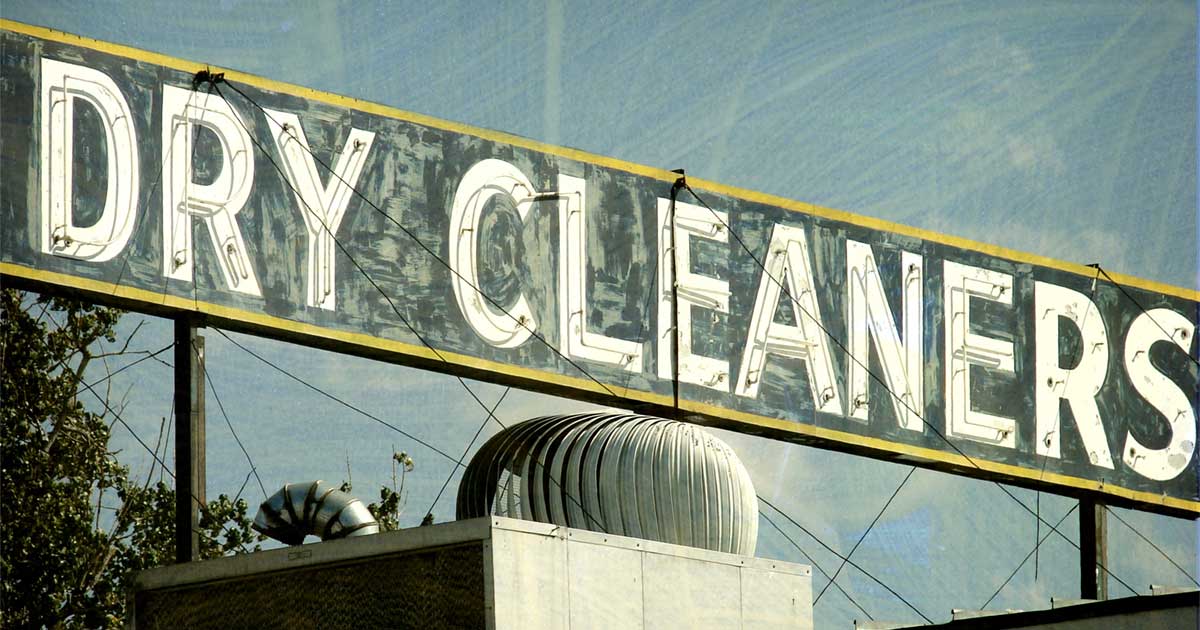AS DRYCLEANERS MOVE AWAY FROM PERC, WE WILL STILL BE DEALING WITH ITS LEGACY FOR YEARS TO COME.

BY: JEFF CARNAHAN
Taking a step back and looking at the history of drycleaning, I see a few major subdivisions of time:
- The dangerous days when highly flammable petroleum solvents caused many fires.
- The developing days when early generations of machines and chemical management practices caused much pollution.
- The contemporary/future days when the industry has moved away from hazardous chemicals altogether and the environmental component of the industry has all but been eradicated.
From my perspective, we are currently in a transition period between the developing days and the contemporary/future days. Some folks are safely using their Perc machines still, as today’s process is much less prone to environmental releases than in the past. However, accidents still can happen. Envision a future day when all drycleaning solvents have become non-toxic and non-harmful to human health and the environment. Waste products will be easily and cheaply managed. Heck, maybe there won’t even be any waste products. I believe that most everyone would agree that this is the direction the fabric care industry is headed. When that day fully arrives, what will be the legacy of the developing days?
THE USE OF HAZARDOUS CHEMICALS AND DRYCLEANING INDUSTRY SHIFTS
A legacy can be defined as a gift from the past. Perhaps not always a gift that we want, but a remnant of sorts, nonetheless. A history of hazardous chemical use will leave a legacy, and in the case of drycleaning it will be left by Perc. Drycleaners are not alone in this regard. Many industries have followed similar patterns over time as their processes, raw materials, and products have evolved. During the Industrial Revolution, many manufacturing companies increased production rapidly with ever-increasing technological breakthroughs that allowed more product to be made at an even faster pace. Chemicals were used abundantly based on their effectiveness, with minimal knowledge of whether they were hazardous or not. Within this void of understanding, waste management practices were based on convenience and the impact to profitability. There was no existing regulation of these chemicals or wastes because it was not clear that it was needed. Once it did become clear, the extra efforts required impacted the business’ bottom line, and there was an immediate shift of mindset toward limiting the use of those chemicals in their operations. Public perception, too, contributed to this shift of mindset. This pattern can still be seen today (e.g. PFAS) as new industrial chemicals are created and put into production. I believe, however, that the fabric care industry’s relationship with hazardous chemicals will phase out with a bit more time.
Learn more about the history of drycleaning solvents and the evolution of the dry cleaning machine
SO, WHAT WILL PERC’S LEGACY BE? HOW WILL WE BE REMINDED OF THE DEVELOPING DAYS OF DRYCLEANING IN THE FUTURE?
Perc and Health Issues
The most prominent remnants will be the contamination issues and the unquantifiable health issues. I’d like to look at these in reverse order. Starting with health issues. There is a surplus of scientific data showing that exposure to Perc is unhealthy. I called the health effects unquantifiable mostly to capture the fact that the most serious are not evident for real-time observation. The primary short-term (acute) symptoms of adverse health effects to Perc exposure are skin reactions from direct contact, and headaches, dizziness, or breathing issues from inhalation of fumes. Some people will have all of these symptoms, and some people won’t feel a single thing out of the ordinary. That makes these acute symptoms seem unreliable for a definitive ruling on the unhealthy nature of Perc.
What is reliable are the long-term study results related to the occurrence of cancer among those who have been exposed to Perc for a defined period. These results show that prolonged exposure to Perc via direct contact, ingestion, or inhalation routes increases an individual’s lifetime risk of getting cancer. That is quantifiable and scientifically derived. There becomes ambiguity and uncertainty around this fact for some due to the high number of other chemicals that people encounter on a daily basis, which also have been found to incrementally increase the chances of getting cancer. In my experience, the doctor doesn’t say, “You have cancer because of exposure to Perc,” they only say, “You have cancer.” Because of this, the legacy of adverse health effects that Perc leaves us is presently difficult to comprehend. Perhaps that will change in the future as medicine advances.
Perc and Environmentally Contaminated Properties
The second, and definitely more tangible, legacy that Perc leaves behind is a great number of contaminated properties. Many have been, or are being, cleaned up to a satisfactory extent every day. However, there are just as many that have not been recognized yet as being impacted by Perc operations. As we’ve discussed before, there are a certain number of business and property-related transactions that may reveal a contamination issue. Examples would be a Phase I Environmental Site Assessment during the buying or selling of a property, a loan refinancing, or the buying or selling of a business. If none of these are undertaken during the post-Perc life of a property, contamination issues may go unnoticed.
Find out what you should do if an environmental investigation has been requested
If not actively addressed during a cleanup action, Perc can remain in the ground indefinitely. It is referred to as a recalcitrant chemical compound because it does not significantly break down under typical, naturally occurring subsurface conditions. A recalcitrant person is willful, unruly, and uncooperative. The same can certainly be said about Perc contamination. If left unidentified and unaddressed, properties that are impacted by Perc could be environmental problems well into the future. We frequently run across former industrial properties that have been abandoned and fallow for decades. They only come to light when property taxes cease to be paid; usually due to former owners passing away, or their businesses going bankrupt and being dissolved. When taxes stop being paid, municipal entities start paying attention and may take a series of actions designed to get the ownership transferred to a new owner or business that will return it to active life. Those actions typically involve a Phase I and Phase II, and that’s when the Perc contamination gets found. Once Perc is identified in these scenarios, one of two things typically happens:
- Public money is used to clean up the property enough for reuse; or
- The property continues to sit idle for a very long time because nobody wants to get involved in a contaminated deal.
During milestone events in any given industry that result in the loss of business for some operators, most recently the COVID-19 Pandemic, these already strapped business owners may choose to keep potential contamination issues undiscovered. This is understandable. I’ve seen a lot of conversations related to how the Pandemic will result in the tragic loss of many small businesses. What I have not seen is the related discussion regarding how the Pandemic could lead to a dramatic increase in the number of orphaned, contaminated commercial properties. If you focus on those that are historical drycleaner properties, you will see the legacy of Perc.
Contact us today to find out how you can protect your property from becoming part of perc’s legacy
As seen in Cleaner & Launderer
 Jeff Carnahan, President
Jeff Carnahan, President
Jeff Carnahan, LPG, has 24+ years of environmental consulting and remediation experience. His technical expertise focuses on the investigation and interpretation of subsurface releases of hazardous substances for the purpose of evaluating and controlling the risk and cost implications. He has been a partner of the drycleaning industry for the past decade and is a frequent contributor to the national drycleaning publication Cleaner & Launderer. He is an industry leader in understanding that environmental risk includes not only cleanup costs, but also known and unknown third-party liability.



